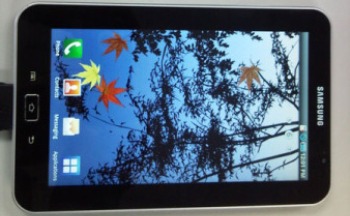Apple chief executive Steve Jobs used his company’s 18 October earnings call to talk some serious smack about Google Android, referring to it as “very fragmented” and a “mess”. That was in the context of Android phones and tablets. But now, it seems, Jobs will have to combat Android in another area: portable media players.
An advertisement for Samsung’s Galaxy Player 50 – the manufacturer’s accompaniment to its Galaxy S smartphones and Galaxy Tab tablet PC – has been circulating online. The spot shows the media player running through various apps: Google Search by Voice, Google Maps, Android Marketplace, camera, camcorder, Layar augmented-reality browser and radio. The device features an external speaker – for subjecting anyone in the vicinity to your questionable choice in music – and Wi-Fi capability.
Feature-laden media player
Blogs such as Samsung Hub have posted the ad. In addition, the Galaxy Player 50 is already being offered for preorder – in 8GB and 16GB versions – by French retailer Materiel.net. According to the latter’s website, the Galaxy Player 50 features Google Android 2.1, a 3.2-inch screen with 400-by-240 resolution, Bluetooth support, a 2-megapixel camera, and the ability to display a wide variety of video and photo formats.
 Materiel.net sells the 8GB version for $276 (£175) and the 16GB for $346, which could hint at a possible price point for when the device migrates to the United States. The actual date of a stateside release, however, is still a very open question.
Materiel.net sells the 8GB version for $276 (£175) and the 16GB for $346, which could hint at a possible price point for when the device migrates to the United States. The actual date of a stateside release, however, is still a very open question.
The other question is how well an Android-powered portable media player would fare against Apple’s iPod franchise, which holds a comfortable lead over other devices currently on the market. In September 2009, Microsoft released the Zune HD, with features including a 3.3-inch touch screen, Wi-Fi capability, an integrated HD radio receiver and high-definition video output for watching 720p content. Despite generally strong reviews, though, the device failed to gain marketplace traction.
Even as Zune HD’s software and design template found themselves integrated into Microsoft’s Windows Phone 7, the company has (thus far) declined to refresh the device itself. That may be an indicator of how Microsoft sees its fortunes in the dedicated media player space, where the Zune HD failed to climb its market share out of the proverbial weeds.
But could an Android device perform better?
Android has certainly been scoring some impressive gains in the smartphone market. According to new statistics from Nielsen, Android handsets have made up some 32 percent of all smartphones sold in the last six months, outpacing both Research In Motion’s BlackBerry and the Apple iPhone. Those numbers, however, account for the period between January 2010 and August 2010, which itself includes only one month of iPhone 4 sales.
Android on the rise
Nielsen pegged BlackBerry’s share of the total US smartphone market at 31 percent, followed by Apple with 28 percent and Android with 19 percent. Despite that third-place finish, a recent note from research firm Gartner suggested that Android will rank second in global mobile operating system share, behind Symbian but ahead of both BlackBerry and iOS.
During Apple’s 18 October earnings call, Jobs claimed that Apple’s App Store, which feeds content to all the company’s mobile devices, “offers users the easiest to use, largest app store in the world”. The online storefront, he claimed, features “over three times as many apps as Google’s marketplace, and offers developers one-stop shopping to get their apps to market easily, and get paid swiftly”.
Given how mobile devices – both music players like the iPod and smartphones – have evolved into handheld app launchers as much as phones or music players, it’s hard to underestimate the value of a centralised and finely tuned app store. Yet Android market share has climbed despite Jobs’ claims about the size of its Marketplace and overall fragmentation.
One of the reasons for Android’s rapid ascent has been the sheer number of devices entering the marketplace. That same proliferation hasn’t happened on the portable media player side of the equation, but if the Samsung Galaxy Player 50 is the first of many devices, what happened in the smartphone realm could conceivably begin to replicate itself in media players. And then Apple, despite having recently refreshed its iPod line, will have yet another battle royale on its hands.





